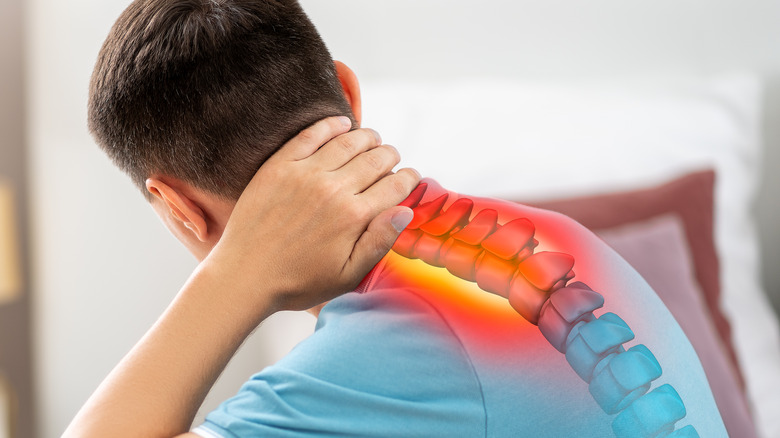Neck Pain Explained: Causes, Symptoms, And Treatments
Neck pain can range from annoying to debilitating, depending on the severity. If you've ever woken up with a stiff neck, you'd be aware of just how important the neck is and how often you use it. Every turn of the head requires the neck, and can be painful if you have an injury or other health problem. Neck pain can last from a matter of days to multiple years, says the Cleveland Clinic. It's also fairly common, according to the article, with one in three people experiencing some type of neck pain each year.
The causes for neck pain can range from wear and tear related to aging, all the way to traumatic injury. A doctor can help if you have neck pain, and there's a variety of treatment options that depend on the severity of your neck problems. Rather than looking at it as a problem caused only by injury to the neck, scientists are beginning to look at it from different angles. A study published in BMC Musculoskeletal Disorders explains that neck pain is multifactorial, and is a major problem in society.
Anatomy of the neck
The spine is long and curved. There are 24 vertebrae that make up the spine, broken down into three sections. According to the American Academy of Orthopaedic Surgeons, the first section is made up of seven vertebrae starting at the top of the spine, which is the base of the skull. It's called the cervical spine, which forms the base of your neck. On top of the spine are ligaments and muscles that provide stability and motion.
Your spinal cord runs through the spine, inside the vertebrae. Parts of it branch out from the vertebrae into other parts of the body. These little branches are called nerve roots. They are nerves that carry messages between the brain and muscles. Between each vertebra in your neck is a soft, gel-like disc called an intervertebral disc. These discs act as shock absorbers for the bones in your spine.
Common neck pain symptoms
There are some telltale signs that there's a problem in your neck. The most noticeable and problematic is pain, which can present itself in a variety of ways. Some people describe it as a persistent ache in the neck, says the Cleveland Clinic. Others would say it's more like a stabbing or burning pain. You might be more sensitive to mild pressure applied to your neck.
While these pains are localized to the neck, there are some additional symptoms the Cleveland Clinic describes that you should watch out for. For example, a headache along with neck pain is common. Numbness or tingling in one or both arms is also possible. You might also feel tightness and increased tension in the muscles surrounding the neck. Since a variety of symptoms can arise from problems at the neck, it can be difficult to figure out what's causing your pain.
Common causes of neck pain
With so many muscles, ligaments, tendons, vertebra, and even your spinal cord running through the neck, there are a number of reasons why you might have pain. A common issue that the American Association of Neurological Surgeons mentions is degeneration of the discs in the cervical spine. Arthritis is another degenerative condition to that can affect the neck. Narrowing of the spinal cord or muscle inflammation are other common causes.
When the spinal cord narrows, there can be increased pressure on nerves that causes pain. Some common things that can narrow the spinal cord include disc herniations and bone spurs. Other risk factors include age, injury, or poor posture.
Problems with the nerves that run through the neck can cause issues in places all over the body (such as the organs), since most of the nerves in the spinal cord run through the neck. There are certain causes of neck pain that are less common, such as cancer and meningitis.
Acute versus chronic pain
In general, when an injury flares up quickly and then goes away, it's considered acute. For example, a paper cut is an acute injury because it happens suddenly but heals in a matter of days.
Meanwhile, chronic injuries last a while and can be difficult to treat. Chronic neck pain can be very uncomfortable and even debilitating. While acute injuries might sound worse, InformedHealth.org explains that they're actually less serious.
Tense muscles (which can be caused by sitting at a computer for too long) or sleeping in an awkward position can cause acute neck pain. Usually, it goes away in a matter of one to two weeks. Symptoms that last longer than 3 months are considered chronic. Psychological stress is a common issue in people with chronic neck pain. Some people with acute neck pain who find relief can have recurring bouts of neck pain if they do something to trigger it, such as a contact sport.
Axial vs radicular neck pain
Acute and chronic pain refer to the length of time you've experienced neck pain symptoms. Meanwhile, axial and radicular pertain to the two types of neck pain symptoms that you can feel.
If you feel pain in the area of your cervical spine, which runs from the base of your skull to the top of your shoulders, you probably have axial pain. The other type, radicular, is a more complex form of neck pain. This type of pain is different from axial, which is felt around the skeleton in the neck.
Radicular pain occurs when a nerve root is irritated. It gets its name from the fact that the pain can radiate down a nerve (via InformedHealth.org). These symptoms are tricky because they can include slower reflexes in the arms and tingling, "pins and needles" sensations. Radicular pain can come from compression of a nerve in the neck, usually from a narrowing of the spinal canal.
Cervical stenosis causes neck pain
Cervical stenosis is the name for narrowing and compression of the spinal cord, and can be a cause of neck pain. It can be caused by degeneration associated with aging, per the American Academy of Neurological Surgeons. One way this happens is when the discs that separate each vertebrae dry out. As a result, they shrink, and the space between the vertebrae gets smaller.
As this occurs, the bones that make up the spine get thicker, as do the ligaments holding them together. This makes the neck more stiff and narrows the space in the spinal canal, which the spinal cord passes through. This can also lead to the creation of bone spurs, which can also press on the spinal cord and cause pain.
Symptoms of cervical stenosis can extend beyond neck pain, and if they become serious, surgery may be required to correct the problem.
Injuries to the neck
Degeneration of the neck and other natural processes can cause pain, but injury is another issue that can come from contact sports or accidents.
The American Academy of Orthopaedic Surgeons explains that the neck is actually vulnerable to injury because it's so flexible and because it supports the head. Car accidents are one way an injury can occur, and wearing a seatbelt can significantly reduce your chance of something bad happening. If someone rear-ends your car, for example, your head can snap back, resulting in a hyperextension injury. It can also tilt forward, resulting in hyperflexion.
When the neck moves too quickly in one direction, it can cause an injury to the muscles or ligaments. A severe injury can cause a fracture or dislocation of the vertebrae. Damage like this can cause paralysis, and is very serious. Falls are another way the neck is commonly hurt, particularly in older people who have poor balance.
When you should contact a medical professional
Neck problems can range from mild to serious, and if you're concerned about your neck pain, it's wise to contact a medical professional.
MedlinePlus provides some helpful guidelines to figure out when you should see a doctor. The first warning signs to look out for are fever and headache. Also, if your neck is so stiff that you can't touch your chin to your chest, you might have meningitis. In this case, they recommend getting to a hospital. Symptoms of a heart attack are also serious, and can include shortness of breath, nausea, arm, or jaw pain. Other reasons to contact a medical professional include numbness, tingling, or weakness in your arm or hand. If your neck pain was caused by a blow, fall, or injury, consider contacting an emergency number like 911.
Neck pain that lasts over a week is concerning, as is pain that wakes you up or keeps you up at night. You can also contact a medical professional if your neck pain is coupled with difficulty swallowing.
Diagnosing neck pain
When you see a medical professional for your neck pain, they can try a few diagnostic techniques to figure out what the problem is. Before any specialized equipment is used (such as an x-ray), your doctor will likely do a physical examination and ask questions about your medical history. Both are key to understanding what's wrong with your neck, according to the American College of Rheumatology.
If initial treatment doesn't help with your neck pain, more specialized diagnostic tools may be used. X-rays and magnetic resonance imaging (MRI) are popular options that allow doctors to see your bones and soft tissue. This enables them to see if there are problems with your discs, muscles, tendons, or ligaments. They can also check for spinal stenosis, tumors, and nerve injuries using these diagnostic tools. Together with the physical exam and medical history, your doctor can get a better picture of what's causing your neck pain.
Treatment options for minor neck pain
If your neck is bothering you but you don't have any major problems, you might be able to cure the symptoms at home. MedlinePlus recommends taking some over-the-counter pain relievers such as Tylenol or Advil. Applying heat or ice to the area that you feel pain can be relieving. They recommend using ice for the first 48 to 72 hours after symptoms develop. Then, switch to using heat. Some sources of heat include hot showers, hot compresses, and a heating pad.
Starting to get back to your normal activities can actually be beneficial, but take things slowly. For example, some gentle head movements can help. Try looking side-to-side and up-and-down, slowly and gently. You can also have a masseuse or your partner massage areas of the neck that are particularly painful. Neck collars might help your neck, but they can also weaken neck muscles if you wear them for too long. Your doctor can help you figure out if you need one.
Ergonomic adjustments for neck pain
Staring at a computer screen for too long while typing away can make your neck sore. Harvard Health suggests a few options for people who want to make ergonomic changes to reduce their neck pain.
One technique is to make your computer screen positioned at eye level. Setting it too high or too low can cause you to tilt your head up or down while you're working.
If you're using a phone, try doing some of the tasks with the spoken (hands-free) features that many phones offer. You can use a headset or wear headphones to give voice commands to your phone so that you don't have to look down at it too often. If you're using a tablet, you can set up a pillow in your lap to prop the screen up. Tilt it up at a 45-degree angle so that you don't have to look down too far to see it.
Surgery for neck pain
Surgery likely won't be the first step your doctor takes if you're experiencing neck pain.
An article from New York University's Langone Health says that surgery may be an option if more conservative treatments haven't worked for months. If your problems stem from a disc herniation, the surgeon will remove the bone spurs or disc fragments that are putting pressure on the nerves in your neck to try to relieve your pain.
Another possible surgery is called a spinal fusion. Surgeons will do this if the vertebra in your neck are unstable. Fusing them together gives you more stability and can help reduce pain. This procedure is useful if a slipped vertebra is causing your pain. After neck surgery, you'll see a physical therapist, who will help strengthen the muscles around your neck so that you can regain normal movement. You might also have to wear a neck brace for a time to keep the neck stable and help it heal.
Other ways to avoid neck pain
Surgery is used in the worst-case scenario, but it's not always appropriate for neck pain. If the cause of your neck pain doesn't require surgery but traditional treatment options aren't working, there are a few other methods you can try.
An article from Harvard Health suggests checking and updating your prescription if you wear glasses. As Dr. Zacharia Issac explains, when you're wearing glasses that aren't ideal for you, you tend to lean your head back more when you can see better.
When you're sleeping, avoid using too many pillows. Stacking your pillows too high under your head can put your neck in an uncomfortable position and possibly contribute to your pain. Avoid lifting heavy objects, such as large pieces of furniture, in case the strain is causing or worsening your back or neck pain. Finally, make sure you're sleeping properly. Lack of sleep can actually worsen musculoskeletal pain, such as the pain you feel in your neck.
Complications of neck pain
While pain in your neck is problematic, other problems can arise as a result of the pain you're feeling.
Johns Hopkins Medicine describes some of the issues that can come along with neck pain. One example is loss of productivity. If your neck hurts and you can't work, you can lose time at your job. This is particularly problematic for people who have to lift objects at work. Nerve damage is another problem, which can send pain to other parts of the body like the arms and legs.
Depression is an unfortunate complication that can stem from back or neck pain, since they can alter your life significantly. Pain can keep you from doing activities you enjoy, and can cause more anxiety and stress than you'd feel normally. Another potential problem is weight gain, since neck pain can keep you from working out in the same way you would without it.














